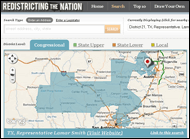Redistricting isn’t sexy: it involves numbers and maps, it’s wonky, and just thinking about it makes voters go to sleep. Which is immensely helpful to the politicians redrawing the lines every few years, because they know that almost no one outside of hardcore politicos is actually paying attention.
But redistricting is where the rubber meets the road in politics, since setting district boundaries is all about power: who has it, who keeps it, and who has a chance to get it in the future. And as the state-level victors of 2010 redraw legislative and congressional districts across the country, they’ll also be establishing the boundaries of power in Congress and 50 different statehouses.
Modern redistricting is a product of database-driven analysis, since it’s only been in the past couple of decades that software allowed politicians to slice and dice neighborhoods down to the precinct level. But those databases are also public documents, which means that the rest of us can keep an eye on what they’re doing. One excellent resource that launched just recently: Redistricting The Nation, a site that combines a Google Maps-style interface, Congressional and state legislative district maps and various kinds of statistical analyses of the districts themselves.
Why statistics? Because one measure of political gerrymandering is the relative “compactness” of a districts, since complicated demographic juggling often yields boundary lines that drift all over the map. The congressional map of Austin is a particular favorite of mine, since that bastion of Texas liberalism is split among districts that meander all across South and Central Texas in an obvious attempt to dilute Democratic votes.
The site’s a lot of fun for researchers and political junkies to play with, and the statistical analyses provide a nice confirmation of what an eyeball survey will often tell you right away — when district lines look funny, they probably are. What no statistical analysis can capture is the actual political calculus involved — whose seat is being saved and whose is being sacrificed. The power to redistrict IS political power, and if you want your side to exercise it, get to work on those state legislative races NOW.
– cpd


[…] but knock another out of office in the process. The result? Draw district lines right, and you can swing the balance for years to come. By pushing his allies in Austin to re-redistrict in 2003, for instance, Tom DeLay managed to build […]
[…] in clear and compelling ways on issues ranging from the 2010 Gulf of Mexico oil spill to congressional redistricting the scourge of political robocalls to Third World political corruption to the humanitarian crisis […]